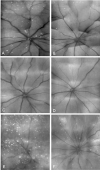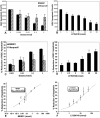Assessment of neuroprotective effects of glutamate modulation on glaucoma-related retinal ganglion cell apoptosis in vivo
- PMID: 16431960
- PMCID: PMC2601027
- DOI: 10.1167/iovs.05-0754
Assessment of neuroprotective effects of glutamate modulation on glaucoma-related retinal ganglion cell apoptosis in vivo
Erratum in
-
Erratum in: Assessment of Neuroprotective Effects of Glutamate Modulation on Glaucoma-Related Retinal Ganglion Cell Apoptosis In Vivo.Invest Ophthalmol Vis Sci. 2025 Jul 1;66(9):33. doi: 10.1167/iovs.66.9.33. Invest Ophthalmol Vis Sci. 2025. PMID: 40643344 Free PMC article. No abstract available.
Expression of concern in
-
Expression of Concern for: Assessment of Neuroprotective Effects of Glutamate Modulation on Glaucoma-Related Retinal Ganglion Cell Apoptosis In Vivo.Invest Ophthalmol Vis Sci. 2025 Jul 1;66(9):34. doi: 10.1167/iovs.66.9.34. Invest Ophthalmol Vis Sci. 2025. PMID: 40643343 Free PMC article. No abstract available.
Abstract
Purpose: To assess the neuroprotective effects of different glutamate modulation strategies, with a nonselective (MK801) and a selective (ifenprodil) NMDA receptor antagonist and a metabotropic glutamate receptor agonist (mGluR Group II, LY354740), in glaucoma-related in vivo rat models of retinal ganglion cell (RGC) apoptosis.
Methods: RGC apoptosis was induced in Dark Agouti (DA) rats by staurosporine (SSP) treatment. Single agents MK801, ifenprodil, or LY354740, or MK801 and LY354740 combined, were administrated intravitreally at different doses. Eyes were imaged in vivo using a recently established technique and the results confirmed histologically. The most effective combined therapy regimen of MK801 and LY354740 was then assessed in a chronic ocular hypertension (OHT) rat model with application at 0, 1, and 2 weeks after OHT surgery and the effects assessed as described before.
Results: All strategies of glutamate modulation reduced SSP-induced-RGC apoptosis compared with the control, in a dose-dependent manner: MK801 (R2= 0.8863), ifenprodil (R2= 0.4587), and LY354740 (R2= 0.9094), with EC50s of 0.074, 0.0138, and 19 nanomoles, respectively. The most effective combination dose of MK801 and LY354740 was 0.06 and 20 nanomoles (P < 0.05), respectively, and the optimal timing of the therapy was 0 weeks after OHT surgery (P < 0.05).
Conclusions: This novel SSP model was validated as a useful tool for screening neuroprotective strategies in vivo. Group II mGluR modulation may be a useful treatment for RGC death. Combination therapy optimized to limit neurotoxic effects of MK801 may be an effective neuroprotective approach in retinal degenerative disease. Furthermore, treatments that minimize secondary RGC degeneration may be most useful in glaucoma.
Figures





References
-
- Quigley HA, Nickells RW, Kerrigan LA, Pease ME, Thibault DJ, Zack DJ. Retinal ganglion cell death in experimental glaucoma and after axotomy occurs by apoptosis. Invest Ophthalmol Vis Sci. 1995;36:774–786. - PubMed
-
- Osborne NN, Ugarte M, Chao M, et al. Neuroprotection in relation to retinal ischemia and relevance to glaucoma. Surv Ophthalmol. 1999;43:S102–S128. - PubMed
-
- Martin KR, Levkovitch-Verbin H, Valenta D, Baumrind L, Pease ME, Quigley HA. Retinal glutamate transporter changes in experimental glaucoma and after optic nerve transection in the rat. Invest Ophthalmol Vis Sci. 2002;43:2236–2243. - PubMed
Publication types
MeSH terms
Substances
Grants and funding
LinkOut - more resources
Full Text Sources
Other Literature Sources
Medical

